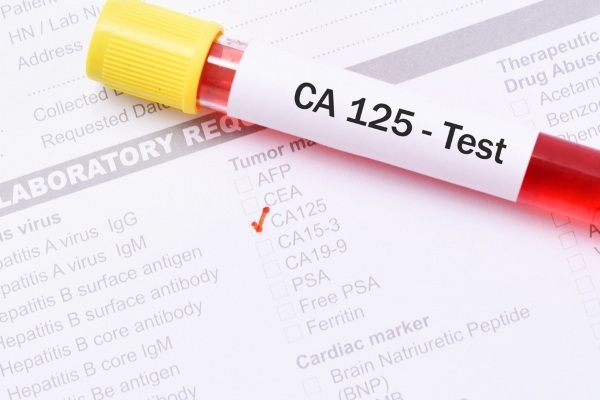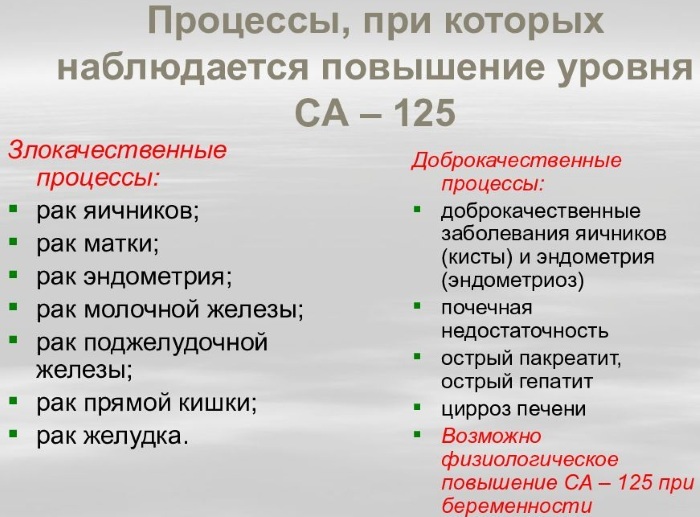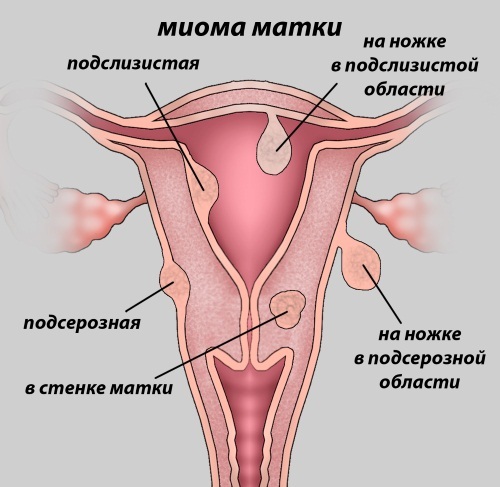Deviation of CA-125 value tumor marker from the norm in women, it allows one to suspect the onset of cancer when there are still no signs of the disease. With correct preparation for the survey, there is a high probability of obtaining reliable results.
Record content:
- 1 The value of the tumor marker
- 2 Indications for taking the analysis
- 3 Preparation for research
- 4 Analysis
- 5 Decoding the results
- 6 Reasons for exceeding the norm
- 7 Where can I take
- 8 Video about CA-125
The value of the tumor marker
CA-125 tumor marker (the norm in women should be within the acceptable range of values) is a protein that allows diagnose cancer of the ovaries, peritoneum, digestive tract, liver, respiratory tract, and monitor the course of cancer process. It also allows you to detect a number of diseases of a benign nature.
The detection of tumor markers allows one to suspect cancer at the very beginning, to find out where growth began malignant tumor, track the dynamics of pathology after the start of therapy, carry out large-scale screening research. When the test results showed a high level of them in the blood, the patient is referred for additional examinations, without which a diagnosis cannot be made.

With the help of an analysis for tumor markers, it is possible to determine whether there will be a recurrence of cancer several months before the appearance of signs of the disease in a person.
Indications for taking the analysis
CA 125 or, as it is also called, an ovarian cancer tumor marker or carbohydrate agent-125 is a high molecular weight glycoprotein. In the absence of pathology, it can be found in the inner layer of the uterus, peritoneum, pleura, pericardial sac, textiles, in the blood of pregnant women, amniotic fluid, breast milk.
With the growth of malignant tumors, the glycoprotein content increases and it can be detected on tumor cells of the ovarian epithelium.
CA-125 tumor marker (the norm in women changes approximately six months before the visible clinical symptoms of oncological processes) it is recommended to investigate the following groups of persons:
- Women at risk of oncology, incl. having close relatives with ovarian cancer. There is a high probability of developing an oncological process in women who have not had pregnancies, have an ovarian cyst, were overweight at the age of 18, receiving estrogens and progesterones in postmenopausal women.
- Individuals who have already undergone cancer therapy. The rules have been established according to which it is necessary to determine the values of the indicator before and after surgery, chemotherapy, radiotherapy, hormonal therapy. To assess the patient's condition, blood within 1 year after therapy must be donated every month, during the 2nd year, once every 2 months, during the 3rd year, once a quarter.
Studies on the CA-125 tumor marker are prescribed for the purpose of:
- to identify malignant neoplasms of the ovaries, including until the woman has characteristic signs of the disease;
- control the course of the oncological process;
- evaluate the success of ovarian cancer therapy;
- detect the re-growth of a malignant neoplasm.
It is recommended to donate blood for the detection of CA-125 tumor marker when signs that may indicate the onset of ovarian cancer:
- constant disruptions of menstruation (but this symptom is not characteristic, since there are cases when regular menstruation persists even when both ovaries are involved in the oncological process);
- high ESR;

- feeling that the bladder is not completely emptied;
- Mucous vaginal discharge, in which you can see blood (usually they do not have an unpleasant odor);
- pain in the abdomen and lower back, with intimacy;
- stool retention, bloating, heaviness in the abdominal cavity, digestive problems;
- impotence, weight loss, mood swings, depression;
- an increase in the abdomen caused by the accumulation of fluid in the abdominal cavity;
- drastic weight loss for no reason;
- subfebrile temperature, which does not decrease within 2 months;
- nausea and vomiting;
- pain during bowel movements and emptying of the bladder;
- lymphadenitis.
All of these signs are not specific. Most women go to the hospital when ascites begins, indicating that the growth is large and metastasized.

The analysis is assigned in the following cases:
- before the start of therapy for a malignant neoplasm in order to compare the obtained values with the results of the study, which will be done after the completion of treatment;
- with an already diagnosed malignant tumor of the ovary;
- after the end of cancer treatment.
Preparation for research
For the results to be reliable, the following recommendations must be observed:
- Within 3 days before the test, you need to follow a diet. You can not eat fatty, spicy, smoked and fried foods. You also need to give up strong tea, especially sweet tea, coffee, carbonated drinks, juices, alcohol.
- You must not smoke half an hour before taking the biomaterial. Sometimes doctors recommend refraining from cigarettes the day before the study.
- 24 hours before taking the analysis, you need to exclude physical labor and strong feelings, give up intimacy.
- 7 days before the study, you must stop taking medications. If this is not possible, the medical staff should be informed of all medications they receive.
- The doctor needs to be informed about all medical procedures that were carried out within a week before taking biomaterial for the CA-125 tumor marker. You cannot undergo an ultrasound scan, biopsy, X-ray, laparoscopy, magnetic resonance imaging and computed tomography and massage a week before donating blood.
In women, when examining the CA-125 tumor marker for compliance with the norm, it is necessary to take into account the day of the menstrual cycle. You cannot take an analysis during monthly bleeding, it is possible only on the third day after their end. A false result will also be if blood is donated for research during an infectious disease or immediately after recovery.
Analysis
The biomaterial for the study is blood from a vein. You need to take it in the morning on an empty stomach. The last meal before the test should be 8 hours before. Sit for 15 minutes before taking blood to calm down. After the procedure, the biomaterial is immediately sent to the laboratory, where it is examined using various test systems.
When there are doubts about the reliability of research results, then the analysis is carried out using test systems from several manufacturers. This improves the accuracy of the study. Also, to obtain more reliable results, you may need not 1, but 2-3 blood samples.
After donating blood, it must be delivered to the laboratory within 1.5 hours, while it must be stored in a special box at a temperature not exceeding + 8 ° C.
Decoding the results
Only an oncologist should decipher the results of the analysis. It must be remembered that it is impossible to make a diagnosis based on this examination alone; it is also necessary to take into account the data of other analyzes and the concomitant signs of the disease.
If the result is positive, the patient must be sent for an ultrasound scan, clinical and biochemical analysis. blood, you may need a biopsy, magnetic resonance imaging, laparoscopy, gastroscopy.
CA-125 tumor marker (the norm in women should be less than 35 U / ml) has optimal values when the analysis results showed a glycoprotein content of less than 15 U / ml.
The study has no age restrictions, but in the climacteric period, the level of CA-125 is closer to the upper limit, and sometimes slightly higher. It happens that ovarian cancer is diagnosed, but the content of CA-125 is within the normal range, since the malignant tumor does not secrete this glycoprotein.
In women with stage I ovarian cancer, CA-125 may be within the normal range; in more advanced cases, it increases several times.
It was found that the survival rate of patients is higher if, after starting treatment for a malignant disease, the content of the tumor marker begins to decrease.
If complete remission of cancer has come, then its level is usually within the normal range, and it is closer to the lowest values. When, during remission, it begins to grow from 0 to 35 U / ml, (but is still within normal limits), then this is may indicate a relapse of the malignant disease, and the woman needs to be sent for additional survey.
When the content of CA-125 is high all the time, then, as a rule, this indicates a poor response of the patient's body to therapy and continued growth of the neoplasm.
Reasons for exceeding the norm
The reasons for the high content of CA-125 can be both physiological and pathological.
A false positive result is possible if the blood sampling was incorrect, for example, a woman did an analysis during monthly bleeding, pregnancy, breastfeeding, did not follow the recommendations for preparing for the examination (smoked, did not keep a diet, experienced stress, came for analysis after a night shifts).
Also, the high content of CA-125 is possibly associated with the development of pathology in the body of various origins.
CA-125 is not a specific tumor marker, and it can indicate other diseases, including non-oncological genesis. It is possible to suspect ovarian cancer, especially in women over 55, when the results of this analysis are overestimated by 2 times. If there is a suspicion of the development of a malignant process, the patient is sent for a second analysis and an additional examination is carried out with him.
There may be a high level of CA-125 in other malignant neoplasms, for example, in cancer of such organs as:
- the fallopian tubes;
- inner layer of the uterus;
- digestive tract;
- pancreas;
- liver;
- breast;
- Airways.
In addition, the CA-125 tumor marker is elevated not because of cancer, but because of the following pathologies:
- endometriosis (according to statistics, with this disease, CA-125 is increased in 85% of patients);
- ovarian cyst;
- diseases transmitted through sexual contact;
- chronic inflammation of the pancreas;
- pleurisy;
- inflammation of the sheets of the peritoneum;
- pericarditis;
- cirrhosis and inflammation of the liver;
- inflammation of the uterine appendages;
- myoma;

- colloidal adenofibroma (this is a neoplasm on the ovaries of the borderline type);
- benign neoplasms, incl. mixed type;
- neoplasms of a low degree of malignancy;
- autoimmune pathologies;
- kidney dysfunction;
- dysmenorrhea.
High CA-125 levels can be present in the first 13 weeks of pregnancy, during breastfeeding and during menstrual bleeding. This is not considered a pathology and therapy is not required.
You need to observe only women in a position who previously had an oncological process or revealed pathologies of the uterus. High glycoprotein levels may be due to viral infection or stress.
Where can I take
CA-125 tumor marker (the norm in women should be periodically monitored) can be passed in a public or private clinic. In the first case, the analysis is done free of charge, but usually you have to wait a long time for a direction for research, and then also for its results.
In a private laboratory, blood sampling for the CA-125 tumor marker is carried out for a fee, the results will be ready in the near future (usually within a day), which allows, if necessary, to start therapy as early as possible and increase the chances of its effectiveness.
You can donate blood for the CA-125 tumor marker in the following private laboratories:
- Invitro. This is one of the largest clinics that has been providing laboratory and diagnostic services since 1995. Currently, it has more than 900 points where you can donate blood. The company also has 9 independent laboratory complexes that conduct various types of research. There are Invitro centers not only in Russia, but also in other countries.
- Hemotest. There are branches of a private clinic in 186 cities of Russia. The company has about 500 branches.
- Citylab. This is the largest network of clinical laboratories where you can donate blood for the CA-125 tumor marker.
- Helix Laboratory Service". It was established in 1998.
If blood is donated in a state clinic, then the study is carried out free of charge, since it is paid by the insurance company that provided the patient with the compulsory medical insurance policy.
In a private clinic, the price is set by the laboratory itself. Since laboratories can use reagents of different price and quality, test systems. Also, the price for the analysis depends on whether the blood is taken in the clinic or the doctor comes to the patient's home.
Analysis cost depending on the region, in rubles:
| City | Helix | Invitro | Hemotest | Citylab |
| Moscow | 785 | 1020 | 790 | 1000 |
| St. Petersburg | 790 | 1010 | 750 | 920 |
| Ekaterinburg | 560 | 905 | 520 | 800 |
| Kazan | — | 580 | — | 535 |
| Nizhny Novgorod | 610 | 735 | 600 | — |
If CA-125 tumor marker in women is higher than normal, then you should not panic ahead of time, but the results of this analysis should also not be ignored. It is imperative to undergo additional examinations to find out what caused the increase in glycoprotein levels, and, if necessary, undergo treatment.
Video about CA-125
Tumor marker CA125 - testicular cancer or not:



